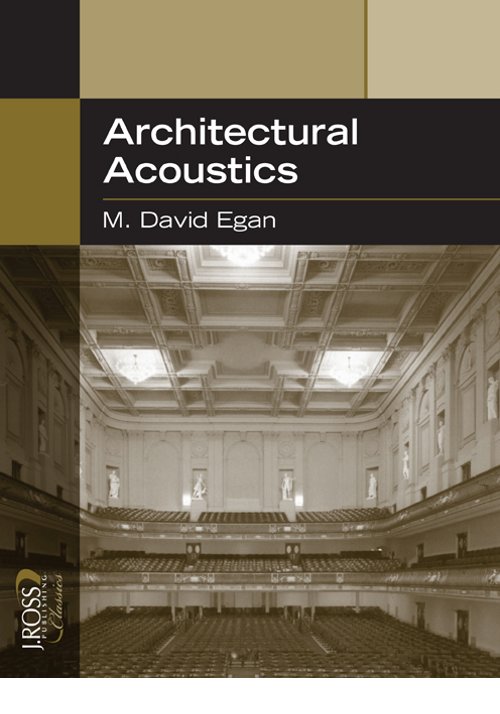Architectural Acoustics
$54.95
M. David Egan
Softcover, 9.5×11, 448 pages
ISBN: 978-1-932159-78-3
January 2007
Description
The goal of this widely used book is to present in a highly illustrated format the principles of design for good hearing and freedom from noise in and around buildings. The more than 540 illustrations are not merely supplements to the text as with nearly all traditional books. In this book, the illustrations are the core of the coverage of basic principles of sound and hearing, sound absorption and noise reduction, sound isolation and criteria for noise, control of HVAC systems noise and vibrations, auditorium acoustics design, and electronic sound systems. The book is written for architects, interior designers, engineers, and all others concerned with the design and construction of buildings who need to know the basics of architectural acoustics, but who do not have the time to digest wordy presentations. Designers who understand the basic principles of acoustics will possess an important new tool for shaping the built environment. Hopefully, not only better acoustical environments, but also better buildings should result.
An unabridged J. Ross Publishing republication of the edition published by McGraw-Hill, New York, 1988, 448pp.
About J. Ross Publishing Classics
J. Ross Publishing Classics are world-renowned texts and monographs written by preeminent scholars. These books have been widely read, discussed, and cited in the literature since their inaugural publications but unavailable for some time to students, researchers, professionals, and libraries. J. Ross Publishing is proudly making these valuable references and texts available once again.
ISBN 10: 1-932159-78-9
Key Features
- Offers more than 540 illustrations to visually explain basic acoustic engineering principles with complete clarity, and tables of engineering data that further enhance understanding and the usefulness of the text
- Contains many valuable checklists of design aids, data tables of sound absorption, and sound isolation properties for a wide variety of building materials
- Presents case study examples of common problems, and step-by-step practical solutions
- Provides handy access to useful formulas, a metric system conversion table, a summary of common building acoustic terms, and extensive references
About the author(s)
M. David Egan, Hon. AIA, is a consultant in acoustics and Professor Emeritus at the College of Architecture, Clemson University. He has been principal consultant of Egan Acoustics in Anderson, South Carolina for more than 35 years. A graduate of Lafayette College (B.S.) and MIT (M.S.), Professor Egan also has taught at Tulane University, Georgia Institute of Technology, University of North Carolina at Charlotte, and Washington University. He is the author of Concepts in Architectural Acoustics, Concepts in Thermal Comfort, Concepts in Building Firesafety, and Concepts in Architectural Lighting (two editions). In addition to consulting, teaching, and writing, Professor Egan is a fellow of the Acoustical Society of America, member of the National Council of Acoustical Consultants, and an Association of Collegiate Schools of Architecture (ACSA) Distinguished Professor.
Table of Contents
Foreword
Preface
Acknowledgements
Introduction
Chapter 1 — Basic Theory
Chapter 2 — Sound Absorption
Chapter 3 — Room Acoustics
Chapter 4 — Sound Isolation
Chapter 5 — Mechanical System Noise and Vibrations
Chapter 6 — Speech Privacy
Chapter 7 — Electronic Sound Systems
Selected References on Architectural Acoustics and Noise Control
Appendixes
Reviews
“M. David Egan’s large-format book Architectural Acoustics…is another important work on our shelf, and is a must for all libraries.” Glen Ballou in S&VC
“Architectural Acoustics is for the intelligent, college-level beginner, with a desire to learn basic concepts, as well as practical computation and design methods. There is nothing else in print that covers as broad an area of acoustics, and covers it in as much depth. It would take a library of a dozen titles to duplicate what’s in this one book, and still that library would not be current (would these titles include references to quadratic-residue diffusers?), or as useful in the hands of an architect.” Ted Uzzle in Sound & Communications
Related products
-

Demand Management Best Practices
Retail Price: $54.95$49.95 Add to cart -

ROI of Software Process Improvement
Retail Price: $59.95$49.95 Add to cart -

Directing the Flow of Product
Retail Price: $59.95$49.95 Add to cart -

Achieving Inventory Accuracy
Retail Price: $49.95$44.95 Add to cart -

Earth Anchors
Retail Price: $79.95$69.95 Add to cart

